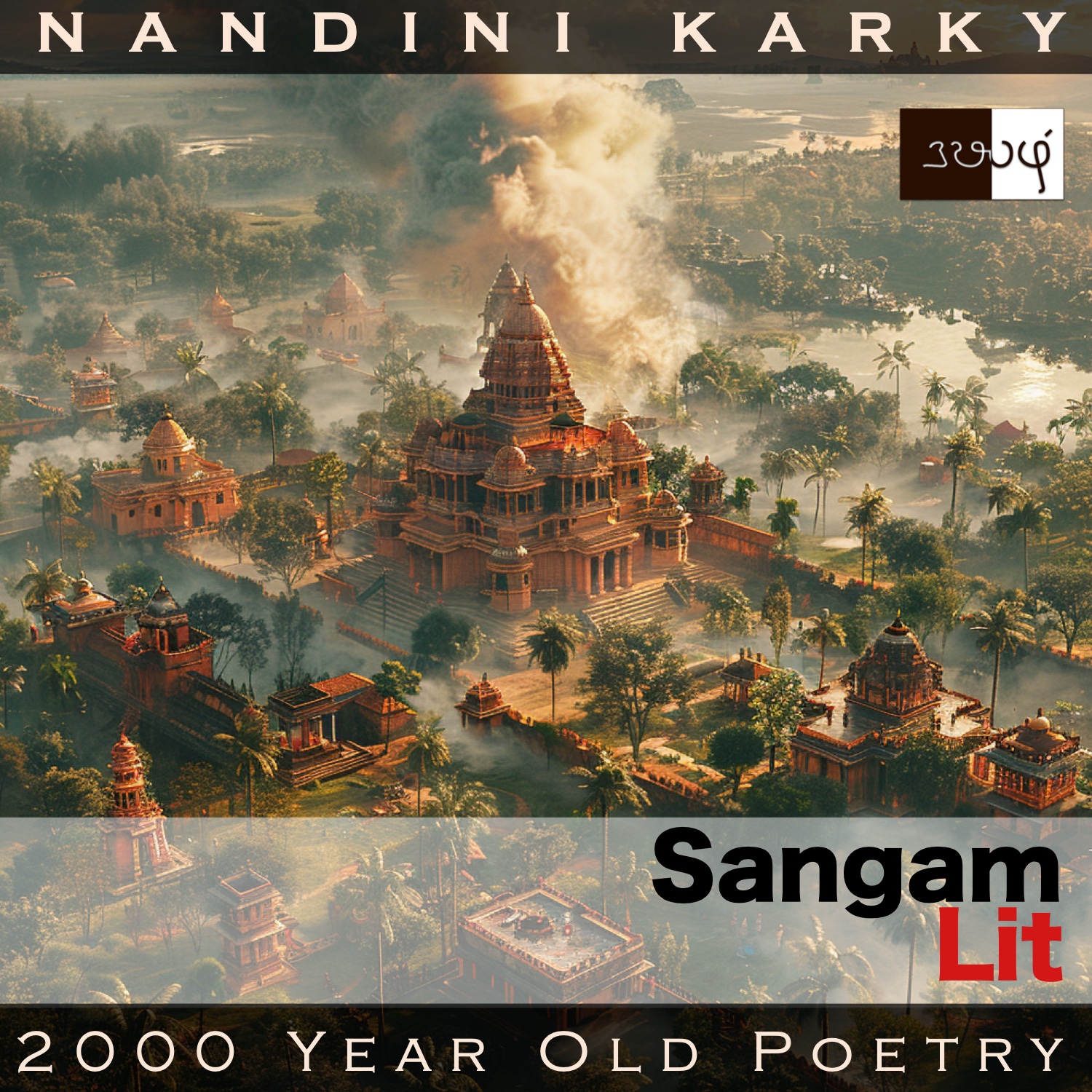Podcast: Play in new window | Download
Subscribe: Apple Podcasts | Spotify | Amazon Music | Android | iHeartRadio | TuneIn | RSS | More
In this episode, we perceive the eagerness of a poet in meeting with a patron, as portrayed in Sangam Literary work, Puranaanooru 379, penned for the Leader Oymaan Villiyaathan by the poet Purathinai Nannakanaar. The verse is situated in the category of ‘Paadaan Thinai’ or ‘Praise’ and paints a portrait of a patron’s generosity.

யானே பெறுக, அவன் தாள் நிழல் வாழ்க்கை;
அவனே பெறுக, என் நா இசை நுவறல்;
நெல் அரி தொழுவர் கூர் வாள் மழுங்கின்,
பின்னை மறத்தோடு அரிய, கல் செத்து,
அள்ளல் யாமைக் கூன் புறத்து உரிஞ்சும்
நெல் அமல் புரவின் இலங்கை கிழவோன்
வில்லியாதன் கிணையேம்; பெரும!
குறுந் தாள் ஏற்றைக் கொழுங் கண் அவ் விளர்
நறு நெய் உருக்கி, நாட் சோறு ஈயா,
வல்லன், எந்தை, பசி தீர்த்தல் என,
கொன் வரல் வாழ்க்கை நின் கிணைவன் கூற,
கேட்டதற்கொண்டும் வேட்கை தண்டாது,
விண் தோய் தலைய குன்றம் பின்பட,
நசை தர வந்தனென் யானே,வசை இல்
தாயிறூஉங் குழவி போல, ஆங்கு அத்
திருவுடைத் திரு மனை, ஐது தோன்று கமழ் புகை
வரு மழை மங்குலின் மறுகுடன் மறைக்கும்
குறும்பு அடு குண்டு அகழ் நீள் மதில் ஊரே.
A verse in which a single theme is presented in two different voices. The poet’s words to this local leader can be translated as follows:
“‘May I be endowed a life in the shadow of his feet; May he be endowed with the praises of his fame from my tongue; When their sickles become blunt, paddy harvesters wanting to continue cutting with the same strength, would treat the curved back of a turtle in the mud as their whetting stone, in the fields filled with paddy clusters belonging to the lord of ‘Ilankai’ Villiyaathan. I’m his ‘Kinai’ drummer! The lord is one who generously renders the fleshy meat of the short-legged male boar, roasted in fragrant ghee, along with rice, every single day, and routs all hunger’. Hearing your Kinai drummer, who has a life of singing in the early hours of dawn, utter these words, with unceasing desire, leaving behind sky-soaring mounds, I rushed with eagerness, just like a baby which rushes to its flawless mother to suckle, and saw fragrant smoke arising from your wealthy and splendid mansion, akin to a rain cloud, hiding the streets around, in that town, having a fort, a deep moat and fenced with walls, all around.”
Let’s explore the nuances. The poet starts by rendering the words of another person, who wishes that his life is at the shadow of that patron’s feet and that he may forever sing his praises. That person goes on to describe the prosperity of the patron’s place by talking about how the paddy harvesters in his domain, seeing their sickles becoming blunt with all the the heavy work being done, wanting not to stop their work, and at the same time, wishing to cut with the same force as before, sharpen their tools on the backs on turtles lying in the mud, by their feet. While this seems like an illustration of the ingenuity and resourcefulness of these ancient farmers, what the poet actually means is that there was so much work to be done in the huge and numerous paddy fields of the leader’s domain that not a moment was to be wasted and that such improvisation was inevitable!
Returning, we see the poet revealing that the land spoken of thus is the city of ‘Ilankai’, ruled by the leader Villiyaathan, and that the person speaking this far was none other than the Kinai drummer, who sings at the patron’s palace. This Kinai drummer goes on to talk about how the leader offers delicacies like the fatty meat of boars, roasted in ghee, along with rice, every single day. Hearing of the leader’s infinite generosity, the poet says, he rushed, crossing hills many, with the same feeling that an infant has when seeking its good mother for milk. When he arrives here, he sees the mansion of this leader covered in fragrant smoke, no doubt cooking the items promised by the drummer. The poet compares this cloud of smoke that hides the streets to rain-bearing clouds, and ends by describing that town as one fenced by walls, having a huge fort and a deep moat.
A verse filled with evocative similes like a child’s innate gravitation to its mother and also images that depict the wealth and prosperity of the town and mansion belonging to this leader. I can’t help wishing that archaeological evidences for such forts and moats as described in these Sangam verses are found for real. Just recently, I was reading about how an ancient village with a circular structure belonging to the Iron age period dating back to the 5th century BCE, much like the one found in Asterix and Obelix comics, was discovered using the LIDAR technology in France, without a single spade in the mud. Heartening to read that the same LIDAR is guiding the excavations of ancient sites in Tamil nadu. More global collaborations in this area will enhance this laudable work of bringing alive the past for the present and future!




Share your thoughts...